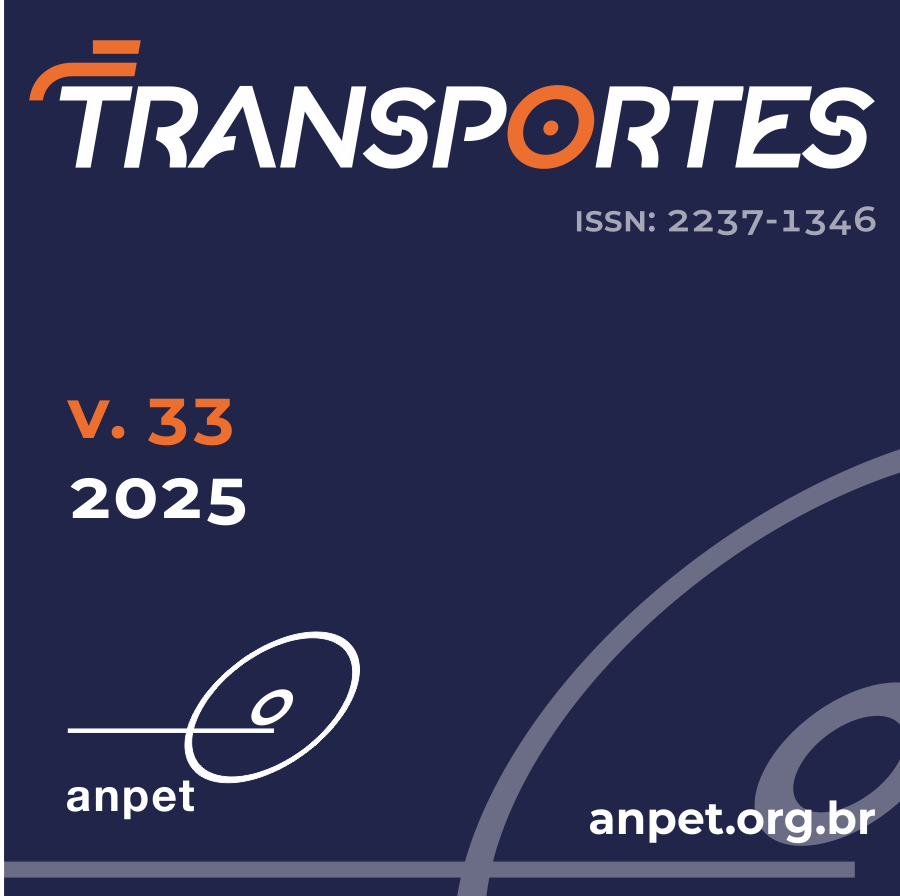Evaluation of the relationship between railway pavement stiffness and the occurrence of rail head fractures
DOI:
https://doi.org/10.58922/transportes.v33.e3093Keywords:
Railways. Rails. Pavement. Fracture mechanics.Abstract
Understanding how rail fractures occur, considering the interaction and influence of the permanent way elements, is essential to mitigate railway incidents and their impacts. This study evaluates the relationship between the structural condition of the railway pavement and the propagation of cracks that appear inside the head rail section until the occurrence of fracture. The Estrada de Ferro Carajás – EFC was adopted as a case study, estimating the time until the fracture, considering the initial condition of the rail defect and the stiffness of the railway pavement. The results indicate that in the EFC sections with less stiffness, the fracture tends to occur significantly earlier than in those with greater stiffness. On the other hand, the larger the defect, the faster the crack evolution, especially in stiffer pavement of EFC. The methodology was applied and validated in a real EFC case. Based on the results, the need to review normative and operational procedures is highlighted, incorporating the structural condition of the railway pavement in the planning of inspections and interventions, as a strategy to prevent critical failures on tracks and improve the operational safety of railways.
Downloads
References
ABNT (2020) NBR 16845: Trilho Vignole – Inspeção ultrassônica - Procedimentos. Rio de Janeiro: ABNT.
ABNT (2021) NBR 7640: Defeitos de trilhos – Terminologia, tolerâncias e tratamento. Rio de Janeiro: ABNT.
ANTF (2024) Informações gerais sobre o Setor Ferroviário de Carga Brasileiro. Disponível em <https://www.antf.org.br/boletim-antf/painel-antf/> (acesso em 01/07/2025).
ANTT (2023) Relatório de Acompanhamento de Acidentes Ferroviários – RAAF. Disponível em <https://dados.antt.gov.br/dataset/relatorio-de-acompanhamento-de-acidentes-ferroviarios-raaf/> (acesso em 01/07/2025).
AREMA (2020) Manual for Railway Engineering. Lanham: AREMA.
Bevan, A.; J. Jaiswal; A. Smith et al. (2020) Judicious selection of available rail steels to reduce life-cycle costs, Proceedings of the Institution of Mechanical Engineers. Part F, Journal of Rail and Rapid Transit, v. 234, n. 3, p. 257-275. DOI: 10.1177/0954409718802639. DOI: https://doi.org/10.1177/0954409718802639
Costa, R.C. (2016) Proposição de Dispositivo de Medidas “In Situ” para Avaliação do Comportamento Mecânico de Lastro Ferroviários: Estudo de Caso na Estrada de Ferro Carajás. Dissertação (mestrado). Universidade de São Paulo. São Paulo, SP. DOI: 10.11606/D.3.2016.tde-30092016-140923. DOI: https://doi.org/10.11606/D.3.2016.tde-30092016-140923
Costa, R.C.; E. Moura; L. Bernucci et al. (2016) Dispositivo de medição de deslocamentos em via permanente para determinação do módulo de via, Transportes, v. 24, n. 4, p. 32-38. DOI: 10.14295/transportes.v24i4.1140. DOI: https://doi.org/10.14295/transportes.v24i4.1140
Hay, W.W. (1982) Railroad Engineering (2nd ed.). New York: John Wiley & Sons Inc.
Indraratna, B.; A. Heitor e J.S. Vinod (2021) Geotechnical Problems and Solutions: A Practical Perspective (1st ed.). Leiden: CRC Press/Balkema. DOI: https://doi.org/10.1201/9781351037341-1
Jeong, D.; Y.H. Tang e O. Orringer (1997) Damage tolerance analysis of detail fractures in rail, Theoretical and Applied Fracture Mechanics, v. 28, n. 2, p. 109-115. DOI: 10.1016/S0167-8442(97)00035-9. DOI: https://doi.org/10.1016/S0167-8442(97)00035-9
Jeong, D.Y. (2003) Correlations between rail defect growth data and enginerring analyses – part I: laboratory tests. United States Department of Transportation, v. 1, p. 1-103.
Jeong, D.Y. e G.C. Sih (1990) Evaluation of Elber’s Crack Closure Model as an explanation of train load sequence effects on crack growth rates. Federal Railroad Administration, v. 1, p. 1-38.
Lamprea-Pineda, A.C.; D.P. Connolly e M.F.M. Hussein (2022) Beams on elastic foundations: a review of railway applications and solutions, Transportation Geotechnics, v. 33, p. 1-32. DOI: 10.1016/j.trgeo.2021.100696. DOI: https://doi.org/10.1016/j.trgeo.2021.100696
Li, D.; J. Hyslip; T. Sussmann et al. (2016) Railway Geotechnics (1st ed.). Boca Raton: Taylor & Francis Group. DOI: https://doi.org/10.1201/b18982
Li, J.; S.I. Doh e R. Manogaran (2023) Detection and maintenance for railway track defects: a review, IOP Conference Series. Earth and Environmental Science, v. 1140, n. 1, p. 012011. DOI: 10.1088/1755-1315/1140/1/012011. DOI: https://doi.org/10.1088/1755-1315/1140/1/012011
Li, Q. e S. Ren (2012) A real-time visual inspection system for discrete surface defects of rail heads, IEEE Transactions on Instrumentation and Measurement, v. 61, n. 8, p. 2189-2199. DOI: 10.1109/TIM.2012.2184959. DOI: https://doi.org/10.1109/TIM.2012.2184959
Lyons, M.L.; D.Y. Jeong e J.E. Gordon (2009) Fracture mechanics approach to estimate rail wear limits, American Society of Mechanical Engineers, Rail Transportation Division, v. 1, p. 1-10. DOI: 10.1115/RTDF2009-18035. DOI: https://doi.org/10.1115/RTDF2009-18035
Magel, E.; P. Mutton; A. Ekberg et al. (2016) Rolling contact fatigue, wear and broken rail derailments, Wear, v. 366–367, p. 249-257. DOI: 10.1016/j.wear.2016.06.009. DOI: https://doi.org/10.1016/j.wear.2016.06.009
ORR (2006) Train Derailment at Hatfield: A Final Report by the Independent Investigation Board. London: Office of Rail Regulation. Disponível em: <http://www.railwaysarchive.co.uk/documents/HSE_HatfieldFinal2006.pdf> (acesso em 01/07/2025)
Orringer, O.; J.M. Morris e D.Y. Jeong (1986) Detail fracture growth in rails: test results, Fracture Mechanics, v. 5, n. 2, p. 63-95. DOI: 10.1016/0167-8442(86)90019-4. DOI: https://doi.org/10.1016/0167-8442(86)90019-4
Orringer, O.; Y.H. Tang; J.E. Gordon et al. (1988) Crack Propagation Life of Detail Fractures in Rails (DOT/FRA/ORD-88/13). Washington: Federal Railroad Administration.
Paiva, C.E.L.; A.P. Buck e A. Ferreira (2018) Sub-ballast performance in Brazilian railway infrastructures, Construction & Building Materials, v. 190, p. 164-169. DOI: 10.1016/j.conbuildmat.2018.09.093. DOI: https://doi.org/10.1016/j.conbuildmat.2018.09.093
Papaelias, M.P.; C. Roberts e C.L. Davis (2008) A review on non-destructive evaluation of rails: State-of-the-art and future development, Institution of Mechanical Engineers, Part F: Journal of Rail and Rapid Transit, v. 222, n. 4, p. 367-384. DOI: 10.1243/09544097JRRT209. DOI: https://doi.org/10.1243/09544097JRRT209
Pereira, P.A.M.; T.F. Alves; R.S. Motta et al. (2023) Estudo numérico computacional e analítico do comportamento estrutural de pavimentos ferroviários com diferentes estruturas, Transportes, v. 31, n. 1, p. e2848. DOI: 10.58922/transportes.v31i1.2848. DOI: https://doi.org/10.58922/transportes.v31i1.2848
Ravaee, R. e A. Hassani (2007) Fracture mechanics determinations of allowable crack size in railroad rails, Journal of Failure Analysis and Prevention, v. 7, n. 5, p. 305-310. DOI: 10.1007/s11668-007-9068-7. DOI: https://doi.org/10.1007/s11668-007-9068-7
Raymond, G.P. (1985) Analysis of track support and determination of track modulus. Transportation Research Record: Journal of the Transportation Research Board, n. 1022, p. 80-90. Disponível em: <http://onlinepubs.trb.org/Onlinepubs/trr/1985/1022/1022-11.pdf> (acesso em 01/07/2025).
Schneider, E.L. (2005) Análise da vida remanescente de trilhos com defeitos transversais desgastados em serviço. Dissertação (mestrado). Universidade Federal do Rio Grande do Sul. Porto Alegre, RS. Disponível em: (acesso em 01/07/2025).
Selig, E.T. e D. Li (1994) Track modulus: its meaning and factors influencing it. Transportation Research Record: Journal of the Transportation Research Board, n. 1470, p. 47-54. Disponível em: <http://onlinepubs.trb.org/Onlinepubs/trr/1994/1470/1470-06.pdf> (acesso em 01/07/2025).
Talbot, A.N.; A.S. Baldwin; G.H. Bremner et al. (1918) Progress Report of the Special Committee on Stresses in Railroad Track. Proceedings of the American Railway Engineering Association, v. 19, p. 875-1058. Disponível em <https://archive.org/details/proceedingsamer27assogoog/page/n1/mode/1up?view=theater> (acesso em 01/07/2025).
Timoshenko, S. e B.F. Langer (1932) Stresses in railroad track. Journal of Fluids Engineering, v. 54, n. 2, p. 277-293. DOI: 10.1115/1.4021826. DOI: https://doi.org/10.1115/1.4021826
Tong, Y.; G. Liu; K. Yousefin et al. (2022) Track vertical stiffness – value, measurement methods, effective parameters and challenges: a review, Transportation Geotechnics, v. 37, n. 1, p. 100833. DOI: 10.1016/j.trgeo.2022.100833. DOI: https://doi.org/10.1016/j.trgeo.2022.100833
Tzanakakis, K. (2013) The Railway Track and its Long Term Behaviour: A Handbook for a Railway Track of High Quality (1st ed.). Heidelberg: Springer Berlin. DOI: 10.1007/978-3-642-36051-0. DOI: https://doi.org/10.1007/978-3-642-36051-0
UOL (2014) Trilho deformado causou acidente de trem que matou 8 em Rio Preto, diz laudo., Uol Notícias, 21 de maio. Disponível em: <https://noticias.uol.com.br/ultimas-noticias/agencia-estado/2014/05/21/trilho-deformado-causou-acidente-em-rio-preto-diz-laudo.htm> (acesso em 01/07/2025).
Vale (2024) Banco de Dados de Inspeção de Trilhos com Ultrassom na EFC – Documento Interno. São Luís: Vale SA.
Winkler, E. (1867) Vorträge über Eisenbahnbau (1st ed.). Praha: Hansebooks.
Woodhead, D.H. (2021) Investigating the performance of rail steels, Fields Journal of Huddersfield Student Research, v. 7, n. 1, p. 1-15. DOI: 10.5920/fields.810. DOI: https://doi.org/10.5920/fields.810
Downloads
Published
How to Cite
Issue
Section
License
Copyright (c) 2025 Luciano de Oliveira, Rosângela dos Santos Motta

This work is licensed under a Creative Commons Attribution 4.0 International License.
Authors who submit papers for publication by TRANSPORTES agree to the following terms:
- The authors retain the copyright and grant Transportes the right of first publication of the manuscript, without any financial charge, and waive any other remuneration for its publication by ANPET.
- Upon publication by Transportes, the manuscript is automatically licensed under the Creative Commons License CC BY 4.0 license. This license permits the work to be shared with proper attribution to the authors and its original publication in this journal, and to be adapted for non-commercial purposes, provided appropriate credit is given and any derivative works are distributed under the same terms.
- Authors are authorized to enter into additional separate contracts for the non-exclusive distribution of the version of the manuscript published in this journal (e.g., publishing in an institutional repository or as a book chapter), with recognition of the initial publication in this journal, provided that such a contract does not imply an endorsement of the content of the manuscript or the new medium by ANPET.
- Authors are permitted and encouraged to publish and distribute their work online (e.g., in institutional repositories or on their personal websites) after the editorial process is complete. As Transportes provides open access to all published issues, authors are encouraged to use links to the DOI of their article in these cases.
- Authors guarantee that they have obtained the necessary authorization from their employers for the transfer of rights under this agreement, if these employers hold any copyright over the manuscript. Additionally, authors assume all responsibility for any copyright infringements by these employers, releasing ANPET and Transportes from any responsibility in this regard.
- Authors assume full responsibility for the content of the manuscript, including the necessary and appropriate authorizations for the disclosure of collected data and obtained results, releasing ANPET and Transportes from any responsibility in this regard.









